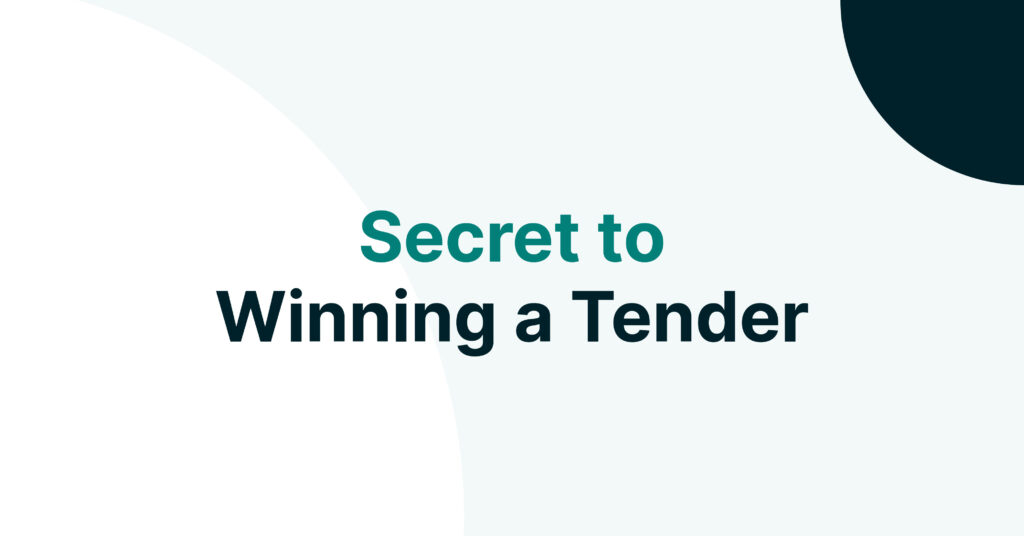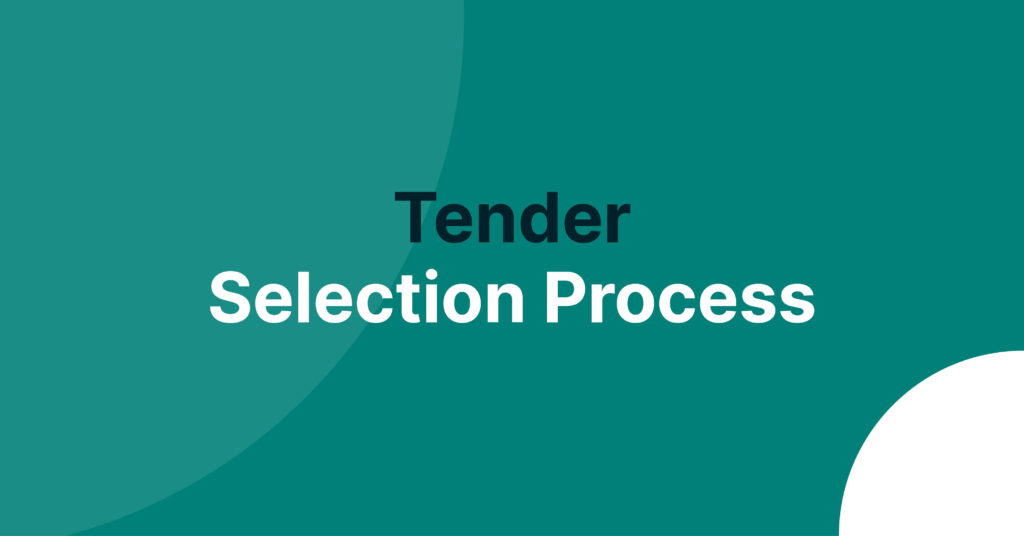Everything you need to know about the invitation to tender process
Learn about the invitation to tender process and win your next bid!
Do you want to win contracts for your company, but are struggling to understand the invitation to tender process?
If you’ve never tendered for work before, the invitation to tender process can look daunting. Even if you have tendering experience, there’s still a lot to wrap your head around.
That’s why we’ve created this blog: to tell you everything you need to know about the invitation to tender process.
Before we explore the invitation to tender process, you need to understand these terms…
ITT
An ITT (invitation to tender) document is typically sent to prospective suppliers after they’ve passed a PPQ (pre-qualification questionnaire). Find out more about PPQs below!
ITT documents can differ in size and scope, but they usually ask for the following information:
- A cover/ITT letter
This is a letter provided to all suppliers who are invited to tender.
- A scope of procurement
This provides the supplier with any information relevant to the contract dates.
- Submission terms
The submission terms outline how you submit the tender. Typically, the buyer will provide suppliers with a timeline that details every step of the tender process.
- A buyer profile
The buyer profile simply provides the supplier with information about the buyer. For example, a typical buyer profile will include information regarding their missions and objectives, relevant background information and context.
- The award criteria
The award criteria will detail how the buyer will assess and evaluate the tender. It should also tell suppliers how the Most Economically Advantageous Tender (MEAT) is assessed through quality and cost ratios.
- Specification
The specification can vary in length depending on the tender. This will outline the buyer’s specifications and the contract’s requirements.
- Separate appendices
The appendices can include any other relevant information, such as pricing schedules, terms and conditions or key performance indicators.
Understanding the components of the ITT document is vital for understanding the invitation to tender process.
PQQ
Another key aspect of the invitation to tender process is the PQQ. This is sometimes referred to as an SQ (selection questionnaire). While not all tenders will require a PQQ, it is still worth knowing what to expect from one.
When required, PQQs will precede an ITT. Basically, buyers use PQQs to filter through prospective suppliers so that only suitable suppliers can proceed to the next stage.
Just like an ITT document, PPQs will typically ask for the following information:
- The status of your organisation
- Details of your finances
- How you manage quality
- Your environmental, social, and health and safety policies
- Case studies and testimonials
PPQs will only be used in closed tenders. With closed tenders, only selected suppliers can apply. If the buyer posts an open tender, then all prospective suppliers are invited to apply.
What’s involved in the invitation to tender process?
So, now you understand ITT and PQQ documents. What’s actually involved in the invitation to tender process?
Let’s go through it, step by step.
- The buyer advertises an opportunity
The first stage of the invitation to tender process – the buyer advertises the opportunity.
There are many different ways to find tendering opportunities. Our sister company, Hudson Discover, houses 11 sector-specific tendering portals:
- Creative Tenders
- Construction Tenders
- Healthcare Tenders
- Facilities Tenders
- Logistics Tenders
- Research Tenders
- Technology Tenders
- Consultancy Tenders
- HR Tenders
- Hospitality Tenders
- Finance Tenders
In each portal, you’ll find all the tendering opportunities relevant to that sector.
- Selection stage
The next stage will differ depending on whether or not the tender is open or closed. For a closed tender, the next step of the invitation to tender process is the selection stage. At this stage, the supplier is required to complete a PQQ.
As we’ve already discussed, the PQQ is used to establish which suppliers are suitable for the contract. The buyer will set out the minimum requirements that prospective suppliers should meet to progress to the next stage. This stage is helpful to buyers, as it prevents time wasting and cuts down the evaluation process. It’s also helpful to suppliers. Imagine wasting your company’s time and resources on a bid that you have no chance of winning. This stage of the invitation to tender process prevents that.
If the buyer posts an open tender, then any and all suppliers can complete an ITT document.
- The buyer evaluates the PQQs
For tenders requiring a PQQ, the buyer will evaluate this at the next stage of the invitation to tender process.
At this stage, the buyer will evaluate each supplier to see who is capable of delivering the contract. Only suppliers that meet the buyer’s criteria will proceed to the next stage.
- Suppliers complete the ITT
Typically, this is the most important part of the invitation to tender process.
Suppliers are asked to complete a series of online questions and provide relevant case studies to support their submission. The ITT is used to assess each supplier and their suitability for the contract. Therefore, it’s important that you make the most of the opportunity to promote your company.
Suppliers can complete their tender response in-house. However, many suppliers choose to outsource to a bid writing company. That way, your tender response is left in the hands of capable, experienced Bid Writers.
- The buyer evaluates the tender submissions
At the penultimate stage of the invitation to tender process, the buyer evaluates each tender submission.
The evaluation criteria will differ from bid to bid, depending on the buyer and contract specifications. However, when you submit a tender, you can expect each aspect of the evaluation criteria to be given a weighting. This is because what matters to the buyer will change depending on the nature of the project.
Your tender response might be evaluated by more than one person on a panel. Alternatively, each panel member might evaluate your response against one element of the criteria.
An overall score will be calculated by multiplying each score by its weighting. Then the results of each assessor will either be added together or averaged to generate your final score.
- The contract will be awarded to the chosen supplier(s)
Now we’re at the final stage of the invitation to tender process. If you’re a supplier, this will be the stage you’re most interested in. It’s time for the buyer to award the contract to their chosen supplier(s).
Anyone who submitted a tender will be informed of the buyer’s decisions, regardless of whether you’re successful or not. You should also receive your final score and any feedback from the supplier.
If you’re unsuccessful with the bid, it’s really important that you take this feedback on board. It can be disheartening to spend time, effort and resources on a tender, only to lose out on the contract. However, you can use the buyer’s feedback to improve for your next tender. You’ll have the opportunity to learn from your mistakes.
If you want to learn more about the invitation to tender process, why not visit Tender VLE?
Now you know the ins and outs of the invitation to tender process. It’s time to learn how to win your next bid!
Tender VLE is the UK’s first virtual learning environment to offer free videos. We offer plenty of online resources and videos to help you understand the tendering process. If you have a question, we’ve got the answer.
Think there’s something missing? We’re always looking for new content ideas. If you think there’s something missing from our site, get in touch and let us know!
Contact a member of the team and get ready to start your journey with Tender VLE.
Need help with a tender right now? Hudson Succeed are here for your business!
With an 87% success rate and over 60 years of collective experience, Hudson Succeed are experts in bid writing. We offer services that will help you secure tendering opportunities for your business. Our expert Bid Writing Team can help you with:
Tender Ready
Our Tender Ready package is a 4-week programme designed to introduce you to the tendering process. One of our highly skilled Bid Writers will work with you to make sure your business is ready to tender.
Tender Improvement
Have you tendered before but are yet to see the benefits of your efforts? Tender Improvement is designed for you. One of our Bid Writers will review your previous tender responses and work to improve them for further tender submissions.
Tender Writing
Choose Tender Writing if you want the whole package. All we need from you is information about your company – then we’ll do the rest. From writing through to submission, a member of our Bid Writing Team will take care of it all.
Tender Mentor
If you’ve written your tender responses and just want a fresh perspective, then Tender Mentor is the package for you. A member of our team will proofread your tender responses, checking for inconsistencies, grammar or spelling errors. We’ll also check your responses to make sure they meet the contract’s specifications. Just ask a member of our Bid Writing Team!
Get in touch with Hudson Succeed and watch your business grow.
Discover Elite
Upgrade to Discover Elite to elevate your tendering experience. Find tendering opportunities for your business, even when you’re busy.
With Discover Elite, you can leave the work to your dedicated Account Manager. Get ready to watch your business grow!
Contact us to find out more.








